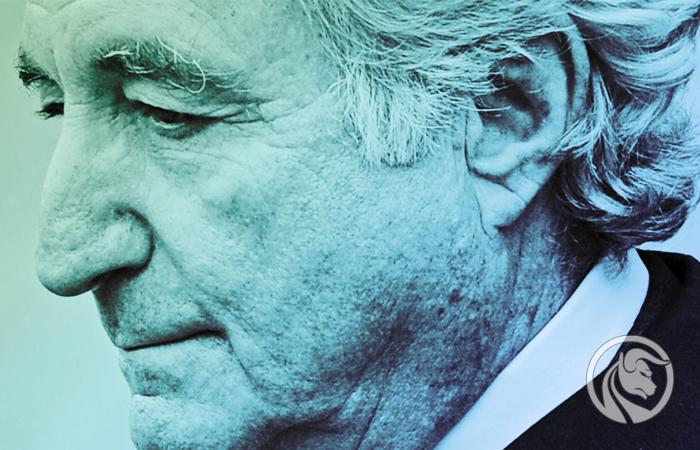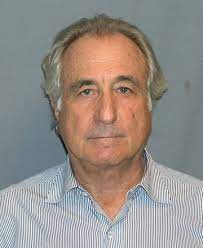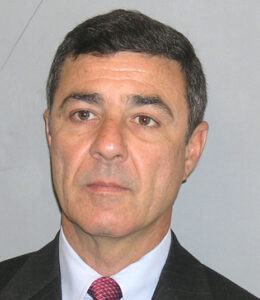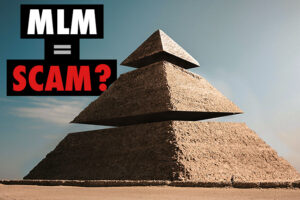Bernard "Bernie" Madoff - contemporary Ponzi
As Warren Buffett says, "only when the tide is low you can see who's been swimming without panties." In 2008, it turned out that such a person was one of the most famous personalities of the American financial world - Bernard Madoff. The popular "Bernie" is certainly a student who has surpassed the master. His pyramid lasted longer and ended in much more serious losses than the famous one Ponzi scheme. The story that will appear on the pages of the portal is a great example that an unblemished reputation from the past may not matter in the present.
The creator of the Madoff pyramid for many years was one of the most respected people on Wall Street. However, due to erroneous investments and the lack of courage to admit his mistake, Bernard decided that he would falsify the investment results and cover the payments with the payments of other fund participants. Thanks to his "great" results and a very good reputation, he was able to keep the lie for many years. The larger the pyramid, the larger its size. It was the Madoff pyramid that led to investor losses amounting to billions of dollars. Initially, the losses from the scam were estimated at around $ 60 billion.
Childhood and education
Bernard Madoff was born on April 29, 1938 in Queens, New York. He was born into a Jewish family, where his father, Ralph Madoff, was a plumber and stockbroker. Bernie's grandparents came from the areas of today's Poland, Romania and Austria. Even though Bernard's family was not the richest, Madoff graduated from Far Rockaway High School in 1956. He then enrolled at the University of Alabama, but after a year he changed to Hofstra University where he completed his BA in Political Science. In 1960, Madoff entered Brooklyn Law School, but after a year he gave up his dream of becoming a lawyer, deciding to open his own business - Bernard L. Madoff Investment Securities LCC (BLMIS).
The beginnings of business activity
The company Bernard L. Madoff Investment Securities initially operated as a broker - dealer for the selected ones penny companies (penny stock). Such companies were characterized by very low liquidity and a wide spread between the bid and ask prices. This meant that Madoff's company found a niche that was too small to attract larger competitors. The accumulated capital was not very large and amounted to $ 5000 (equivalent to less than $ 50 today).
Bernard's funds were too small to make a living only from brokerage and dealership. Therefore, at the beginning he worked as a lifeguard and irrigation installer in gardens. A wealthy father-in-law, Saul Alpern, lent Madoff $ 50 and recommended the company to his friends helped to start the business. One of the first customers was Carl J. Shapirowho invested approximately $ 100. As it turned out later, Shapiro was an investor until the very end of the financial pyramid.
Initially, Madoff's company quoted bid and ask prices through the National Quotation Bureau Pink Sheets. To compete with the larger players who were members of the New York Stock Exchange, his company began using an innovative system to determine the value of quotes. After the system test, attempts began to create something new on the market - he was it National Association of Securities Dealers Automated Quotations Stock Market (NASDAQ). For many years he was the chairman of the NASDAQ.
Madoff's company functioned as a so-called "third market" that allowed investors to buy listed stocks via the OTC market. Institutional investors could purchase blocks of company shares with the confidence that they would remain anonymous. At one point, Madoff Securities was the largest NASDAQ market maker and the sixth largest component market maker the S&P 500 index. Madoff's company also had a management and investment advisory department.
Madoff - propagator of the PFOF system
Bernard Madoff was also one of the defenders of PFOF or "payment for order flow". In a nutshell, it is a bonus paid to the broker for redirecting an order to a specific market maker. In practice, the market maker shared part of the spread with the broker. PFOF has also been referred to as "legal kickback". For some academics, payment for order flow (PFOF) is an unethical practice that may cause brokerage clients to place orders at lower prices. Secondly, the brokerage house may, thanks to the cooperation within the PFOF, reduce the official commission that the client pays, knowing that the individual investor will pay a higher commission in the form of a larger spread.
Now SEC requires brokerage houses to provide clients with information about how much kickback they receive from market makers for passing orders to them. Currently, brokers must place the order so that it is ordered at the NBBO (National Best Bid Offer) rate. For audit purposes, they must provide a set of internal procedures to ensure that client orders are always transferred to the most cost-effective location.
Investment scandal - Madoff's pyramid
The activity as a market maker was carried out in a real way. In 1980, 5% of the volume of stock traded went through Madoff's company. So Bernard was not a person unknown to anyone. Thanks to his activity, numerous grants, charity work and performing important roles in industry institutions, he has gained prestige and trust among influential people. In 2001, Madoff's business foundation was severely weakened. This was due to a change in the trading of illiquid stocks on the NYSE. The decimal system was introduced, which significantly limited the market maker's income. Before the changes, the market maker was earning 12,5 cents on every trade. After the change, earnings fell to around 1 cent. A deterioration in the brokerage and dealership activity would not pose problems for the capital market in the long term.
The scandal broke out because of his investment activity. It was she who aroused admiration even among his competitors. The presented investment results were spectacular and significantly exceeded the rates of return of the broad market. This, in combination with access to wealthy clients, provided excellent conditions for the duration of the financial pyramid.
Madoff's investment strategy
His investment strategy was interesting. Madoff's team usually selected 30 to 35 stocks for the S&P 500. Then a strategy called collar was created. The strategy was to issue call options that were out-of-the-money and then buy put options. Instead of writing and buying options for several dozen stocks, the options on the S&P 500 index were chosen. This was due to the fact that the purchased stocks were strongly correlated with the index, and the index options were more liquid, so the bid-ask spread was small.
The purchase of the put option was to protect the portfolio against the risk of a sharp decline in the S&P 500 index. In turn, the issuance of the call option allowed to reduce the cost of the purchased put option. The writing of the call option meant that the profit limit was limited to the exercise price of the call option. The selection of "better" companies was supposed to generate alpha in the long term, and option strategies were supposed to improve the strategy's results during market sell-offs.
In an interview with Madoff in 1992 to The Wall Street Journal, you could learn the "story" of the strategy. Madoff was supposed to use arbitration on large companies in 1970, which was to generate an average annual rate of return of 18% -20%. In the 80s, Madoff started to use futures contracts in his investment strategy, which allowed for the reduction of commission costs and "hidden expenses" such as the bid-ask spread. During the 1987 crash, the Madoff fund was intended to protect clients' money by purchasing put options.
Already at the turn of the 80s and 90s, there were analysts and journalists who doubted the effectiveness of Bernard's strategy. One of the explanations Barron's made was that the Madoff fund could increase its profits thanks to the front running phenomenon. Front running is a situation in which the broker or institution with access to the order book uses this information to make a profit at the expense of other market participants. For example, the broker receives information that the client wants to buy 500 shares on the block. The broker, through his trading department, quickly buys shares from the market at a price of e.g. $ 000 and then places an order for his client. As a result, the share price rises to $ 100. The broker immediately sells its shares for $ 102. As a result, he made $ 101,85 on every stock he purchased with no risk.
Who were Madoff's victims?
In fact, the investment activity did not generate such fantastic returns as Madoff presented. How could such a financial pyramid exist for so long? One of the reasons was the customer structure. Many of them are charities that did not want to pay out their assets quickly. This allowed Madoff to manage his fragile pyramid. All he needed was a stable market environment and an influx of new clients from which he could pay the withdrawals of old clients. Madoff himself has not been involved in any real trade since the mid-90s. He fabricated his results.
The fund's profitability amounted to an average of 10,5% on an annual basis and was fairly “smooth”, ie did not change significantly from year to year. This minimized capital disbursements and encouraged new investors to contribute their resources to the fund. Due to the fact that the rate of return was not very high, the financial pyramid was much more stable than the Ponzi scheme, which offered a 50% rate of return over 45 days. The longer the fraud lasted, the greater the difference between the actual level of assets and their actual value.
Bernard Madoff built his reputation in the 70's and 80's. Thanks to a successful company, he was portrayed as one of the icons of Wall Street. The fact that he did not use intrusive advertising helped in building his financial pyramid, but he focused on very wealthy clients who were convinced that by entrusting their funds to Madoff, they were joining the elite group of the "chosen ones" of the financial genius.
Very often, Bernie was picky and gave the impression that he was doing his clients a favor, wanting to take money from them. In addition, the fact that he was of the Mosaic faith helped build trust. Thanks to this, he managed to build good relations with wealthy owners of companies or foundations who were of the same religion as him. As the Associated Press mentioned, many clients "trusted him because he was Jewish."
Network of contacts and relations with regulators
A big bonus that Madoff had over the less sophisticated financial scammers was his organization and the ability to build a network of contacts. It was the good relationship with regulators that allowed to "put out fires" when Bernard's business began to attract the attention of some officials, journalists and competitors.
Madoff's family held high positions at SIFMA (Securities Industry and FInancial Markets Association), which was established as a result of the merger of SIA (Securities Industry Association) with BMA (Bond Market Association). SIFMA is an organization dedicated to representing the financial industry to regulators. The organization unites brokers-dealers and asset management companies. SIFMA brokers-dealers generate over of industry revenues. By contrast, asset management companies that are owned by the organization hold about half of all assets under management owned by US investors. Peter Madoff - brother of the creator of one of the largest pyramids in history - spent two terms on the SIFMA council. Additionally, between 2000 and 2008, the Madoff brothers made donations totaling $ 56 to the organization.
Niece Bernard - Shana Madoff - between 1995 and 2008, she was active in the Compliance & Legal area of the aforementioned organization. The fact that Shana was responsible for compliance at Bernard L. Madoff Investment Securities lends a flavor to the whole matter. In 2007, she got married Eric Swansonwho worked for many years in the most important regulator of the US capital market: SEC.
Madoff was also an active member of NASD (National Association of Securities Dealers), which was a body dealing with self-regulation of the activities of dealers and brokers, e.g. by introducing recommendations regarding the conduct of business by these institutions. At one point, Bernard Madoff was the chairman of the Board of Directors at NASD.
Madoff's activities on the censored
1991 – 2003
Many analysts, journalists and scientists doubted the reality of Madoff's actions. One such person was the mathematician Edward O. Throp, who noticed some inconsistencies in the reports of this "genius investor". One of the examples was the transactions of April 16, 1991 on options of Procter & Gamble. Madoff mentioned that he purchased 123 call options on P&G shares that day. Edward O. Throp noted that only 20 P&G options with these parameters were acquired that day. Madoff's activities began to attract the attention of regulators.
In 1992, the SEC launched an investigation into the Madoff's "feeder fund" in Avellino and Bienes, which originally belonged to Bernard's father-in-law, Saul Alpern. The regulator's attention was drawn, as they wrote in an internal memo, to the fund's “astonishingly stable” performance (between 13,5% and 20%) and the suspicion of selling previously unregistered securities. Thanks to the work of Ira Sokrkin, the penalty was only $ 350. Additionally, the fund had to close, but the SEC did not open a thorough investigation. This allowed Madoff to avoid uncomfortable questions.
A great example that Madoff's scam wasn't perfectly masked is the story of Rob Pocard of the Royal Bank of Canada (RBC). Rob was looking for a low volatility investment and in 1997 employees of Termont Group (one of Madoff's "feeder funds") referred him to Bernard. An RBC employee disbelieved Madoff's assurances and demanded a more detailed explanation of the strategy. It was then that he noticed that Bernard was beginning to get confused about his explanations. Rob Pocard realized that either Madoff did not understand the issue or he did not do what he was so eager to talk about at the beginning.. As a result, the potential client broke off contacts with Madoff and Termont Group employees. However, the RBC employee did not report his doubts to the supervisors. He lacked compelling evidence of Madoff's suspicious activities.
The chief regulator of the US capital market began an investigation into Madoff in late 1999/2000. The SEC suspected that Madoff's firm was illegally concealing customer orders. In 2001, an investigation revealed no significant shortcomings in the activities of Madoff and his company.
After a series of articles in 2001 when Barron's and MARHedge took on Madoff's business, the hero of the articles expected the SEC to investigate him. According to testimony in 2008, he was surprised that the American regulator was not interested in the subject. Barron's was surprised that Bernie's clients were not interested in exactly how the strategy worked. According to the journalist Erin Arvedlund, there was a chance that such high profits were possible thanks to the front run. Madoff, in his testimony before the court, mentioned that “this woman [i.e. E. Arvedlund] had no idea what she was writing about ”. MARHedge mentioned that the chances of Madoff's strategy generating 72 profitable months in a row are unlikely.
Interestingly, in Madoff's venture invested, inter alia, one of the best funds in the world: Renaissance Technologies. In 2003, he began reducing his exposure. The reason was suspicions about the fund's consistent earnings. Since Madoff could generate such fantastic results, he should have charged higher management fees. Another doubt that Renaissance Technologies analysts had was that the volume of options did not match the size of the assets under management. This meant that either the data was manipulated or the fund was not faithful to its own strategy.
2004 – 2007
Another suspicion emerged in 2004 after a series of articles about a possible front run. The SEC launched an investigation, which after a year found no inaccuracies in the company's operations. Another SEC investigation continued in 2006. It was investigated whether Madoff had created an activity that resembled a Ponzi scheme in its mechanism. In 2007, the investigation did not reveal any significant flaws.
In 2007, Madoff's activity attracted the attention of FINRA (Financial Industry Regulatory Authority), which deals with the supervision of brokerage activities. FINRA reported that some Madoff parts do not have any customer. Another red flag caused the SEC to start investigating again. It was also intended to investigate the relationship the Madoff family had with regulators and industry organizations.
Harry Markopolos - the one who decoded Madoff
The immaculate opinions about Madoff were starting to crack. In May 2000 Harry Markopoloswho was a financial analyst and portfolio manager at Rampart Investment Management reported to the SEC a suspicion of a crime by Bernard Madoff's company. This was due to the conclusions Harry had reached while fulfilling his official duties. Then Markopolos' supervisor asked to create a system that would replicate the "madoff" strategy in the options market. Very quickly, Harry realized the numbers were wrong. It was impossible to achieve the rate of return claimed by Madoff with the proclaimed strategy.
According to Harry Markopolos, there were only two options for achieving such rates of return: front running or data fabrication. He doubted the possibility of hedging Bernie Madoff's wallet with a quoted put option. He also did not believe in the assurances that funds hedged OTC (OTC) options via UBS and Merrill Lynch. According to Markopolos, these two banks are unlikely to assume such a high risk. Even if they took such a risk, the bonuses would be so high that the strategy would not be profitable.
Harry Markipolos announces his doubts publicly
For more on Harry's doubts, see a memo called "The World's Largest Hedge Fund is a Fraud." The memo was presented to The Wall Street Journal in 2005, but the newspaper chose not to publish the text.
The analysis of a potential Ponzi scheme was very detailed and included as many as 30 red flags. Each of the flags raised doubts as to the feasibility of investment activity. It was a thorough analysis of Madoff's approximately 14 years of activity. One of the charges was that the strategy generated only 7 months of losses during the period under review. This meant that the periods when the strategy generated losses were statistically insignificant.
The largest reported monthly loss was 0,55%. Moreover, the capital growth curve rose steadily on a slope close to 45 degrees. In such a volatile market, such results would be difficult to sustain. Additionally, the high fees charged by Madoff were a problem. If investors earned 12% a year, it meant that the strategy had to generate a minimum of 16% of gross profit. According to Markopolos, such a fund operating according to such a strategy could not exist.
Other red flags
To hide his positions from overseers' eyes, Madoff sold his assets before the end of the quarter. When asked about the aforementioned strategy, he said that it was due to reasons of protecting his market advantage.
Another red flag was the company selected for the audit. Instead of using reputable, largest auditing companies, the choice fell on a small company: Friehling & Horowitz. The auditor employed only one accountant - David F. Friehling. The fact that David was a close friend of Bernie adds to the flavor of the whole affair. Moreover, the auditor himself invested his resources in the fund. There was an obvious conflict of interest.
It is worth quoting an anecdote that proves the choice of the auditor. One of the employees of the Aksia LLC hedge fund advised clients not to invest in a Madoffa fund, because such a small auditor cannot thoroughly investigate the mass of market transactions concluded by such a fund. The situation was even less transparent because one of Madoff's companies was a broker - the dealer through which all the fund's transactions went through.
Another puzzling sign was Madoff's reluctance to allow customers to access their account online. Statements were sent by post, while the market standard was sending such documents via e-mail.
Nothing can last forever - the collapse of the financial pyramid
The first problems started in 2005, when due to the collapse of the Bayou Group financial pyramid investors demanded a payout of $ 105 million. At the same time, Madoff's account was just $ 13 million. Madoff survived the crisis with a transfer of $ 342 million in funds belonging to Madoff's second firm, the broker-dealer. The situation calmed down in 2006, but it was far from perfect.
The problems started again in 2007 when liquidity problems arose in the US capital market. As Markopolos mentioned, already in June 2008 there were signals that Madoff was having liquidity problems. This was because Bernie began to accept the so-called leveraged money. This type of funds is the least stable as customers may unexpectedly request immediate withdrawals for margin call reasons. Despite its disadvantages, it ensured that the funds on the account were raised, which allowed the Ponzi structure to continue.
The market situation in 2008 was very difficult. In March 2008, Bear Stearns went bankrupt. As a result, many customers who had not withdrawn their funds for many years preferred to withdraw their profits. This disrupted the already severely weakened financial pyramid. Worse, the problems were just beginning. In September, Lehman Brothers collapsed and a well-known insurer such as AIG (American International Group) was close to collapse. Huge bailouts avoided the collapse of the financial system, but failed to restore investor confidence. Madoff began to receive requests to withdraw funds entrusted.
A payoff wave had begun that could not be realized. Madoff played against time, hoping that, as in 2005, he would also be able to deal with the crisis this time.. The decline in liquid assets left Bernie in desperate need of new capital. The falsified data helped. Many investors believed that it was Madoff's investments that would provide a safe haven for savings. Inflows in November amounted to only $ 300 million, which did not allow to cover all withdrawals.
To save liquidity, London-based Madoff Securities International (MSIL) transferred $ 164 million to Bernard L. Madoff Investment Securities (BLMIS). Interestingly, MSIL did not have any clients or a register of capital market transactions to justify having such funds.
In such a difficult situation, Madoff did not hesitate to ask his friends for an injection of cash. In early December, he received $ 250 million from his 95-year-old friend Carl J. Shapiro. It is noteworthy that Shapiro has invested in Madoff's ventures for 40 years. During this time, he entrusted Madoff with hundreds of millions of dollars, but at the same time he paid out much more as a result of the payout of profits. To clear the name of the foundation that invested in BLMIS, he donated $ 625 million.
Despite the injection of new capital, the case was lost. Madoff was sure of it just after Thanksgiving. Liquid assets fell from $ 5 billion (the 2008 high) to just $ 234 million. On December 4, 2008, Bernie asked Frank DiPascali, who was in charge of managing the liquidity side of the pyramid, to distribute funds to family members and “privileged” investors. Five days later, Madoff told his brother that he was about to go broke. Bernie also tried to raise funds from "selected" clients, whom he offered the opportunity to invest in a new vehicle. Unfortunately for Bernie, it was not possible to raise $ 5 billion quickly.
On December 10, 2008, Bernard suggested to his two sons that the company pay out a $ 170 million bonus two months faster. Madoff's Sons - Mark and Andrew - questioned the sense of paying employees money when the company has problems paying investors. Bernie asked his sons to speak to him in his apartment. There he admitted that all the company's activities were "one big lie" and that "it was finished". After talking to my father, the sons informed the government of the suspected crime. As a result, Madoff was arrested the next morning.
Cooperation investigation
Madoff heard allegations of financial fraud, money laundering and violation of the securities law. Due to the gigantic fraud, the court sentenced him to 150 years in prison. In 2020, lawyers tried to get Bernard out of prison. They argued that the defendant's poor health did not allow him to serve his sentence in prison. The court did not accede to the position of defense lawyers. Madoff died in prison, still 138 years old to his sentence.
Madoff's assets were confiscated to cover customer claims. The scammer's children and wife experienced social ostracism and hatred from the deceived customers. Bernard cheated over 13,5 thousand. clients (individual and institutional). Irving Picard was hired to recover funds from the financial pyramid. He recovered about $ 13 billion from the beneficiaries of the financial pyramid.
Wall of Shame - people involved in the activities of Bernard Madoff
Such a large financial pyramid could not be managed by just one person. Bernard Madoff needed partners. Lawyers, accountants, transfer managers and creators of purchase and sale orders for financial instruments were needed.
One of the people involved in the Madoff scandal was Jeffrey Picower and his wife. Jeffrey was an attorney, accountant and investor who handled buyouts for healthcare and IT companies. He has invested over $ 1 billion in Madoff vehicles. According to the court, Jeffry should have realized that the rates of return were "incredibly high". For example, Picower's portfolio earned 950% in 1999, and from 1996 to 1998, rates of return ranged from 120% to 550%.
In June 2009, Irving Picard, who dealt with decommissioning the Madoff pyramid, filed a lawsuit with the US Bankruptcy Court, demanding a return of $ 7,2 billion in profits from Picower. Jeffry couldn't stand the pressure of Madoff's pyramid. On October 25, 2009, he died of a heart attack in his swimming pool. In December 2010, Jeffrey's heirs had to pay the victims $ 7,2 billion.
Another convicted person was Peter Madoff (Bernie's brother)who worked as a CCO (Chief Compliance Officer) at the creator of the pyramid. In the beginning, he helped create a computerized trading system that helped in the real activity of the broker-dealer. In the last 20 years of the scam's operation, Peter has been in the day-to-day operations. He was sentenced to 10 years in prison.
Responsibility for the activities of Bernard Madoff also affected his relatives, an example of which is Bernie's wife - Ruth Madoff. Ruth has agreed to take most of the assets valued at over $ 80 million if she receives 2,5 million assets. The retained assets were not exempt from private claim. As a result, in 2019, Ruth agreed to pay $ 594 to Irving Picard. Additionally, all the assets left behind are not subject to inheritance after death. Moreover, she is forced to submit reports to Picard if her expenses exceed $ 100. This is to make sure he doesn't have any hidden accounts.
Next in line were Bernie's son Mark and Andrew Madoff. They worked in the legal trading part in a New York office. Mimio's assets were frozen at the end of March 2009. Although Mark and Andrew distanced themselves from their father's activities, for many commentators it was simply a ploy to protect their estates from lawsuits. On October 2, 2009, Irving Picard sued Madoff's sons for nearly $ 199 million. The lawsuit also included Bernie's brother (Peter Madoff) and his daughter Shana. The fight against the accusations and social ostracism caused Mark Madoff to commit suicide by hanging on the second anniversary of his arrest (December 11). His brother outlived him by less than 4 years. On September 3, 2014, he died of cancer at the age of 48. Only in 2017, it was possible to recover $ 23 million from the property of the deceased brothers.
Another person who was involved in the scandal was David G. Friehling, who acted as an auditor at Friehling & Horowitz. He agreed to cooperate with the authorities to ease his sentence. On March 18, 2009, he was accused of financial fraud, helping to maintain the financial pyramid. He was sentenced to one year of house arrest and one year of life under supervision. The reason for such a low penalty was the complete cooperation with the investigating authorities and the lack of knowledge about the actual scale of the fraud.
One of the key people to they assisted in the creation of the financial pyramid was Frank DiPascali. Officially he worked as CFO (Chief Financial Officer) and Director of Options Trading. In 2009, an investigation began in which DiPascali was charged with fraud, violating the securities law, document forgery and money laundering. He was also sued for $ 170 billion, an amount entrusted by investors that was then distributed to other clients. During the trial, he agreed to assist with the investigation in order to "put the dots together". He did not live to see the sentence because on May 7, 2015, he died of lung cancer.
He was involved in Madoff's pyramid famous investor and philanthropist - J. Ezra Merkin. In April 2009, a civil lawsuit was filed against Merkin for "defrauding hundreds of investors" by transferring $ 2,4 billion into Madoff funds unbeknownst to customers. As a result, he collected approximately $ 470 million in commission over the years. Merkin told his clients that he was actively managing funds. He did not mention in any quarterly report or investor presentation that his hedge funds were actually intermediaries between Madoff and clients. On June 22, 2012, Merkin agreed to pay $ 405 million in commissions to customers to cut off the scandal.
Of course, the number of people involved in Madoff's pyramid was very long. Suffice it to mention that two employees Joann Crupi and Anette Bongiorno they were arrested in November 2010 and sentenced to 6 years in prison. Employees were responsible for fabricating Madoff's investment documents.
Summation
Madoff's story is a great example that even the most famous and respected person can be a fraud. For this reason, any market participant should be skeptical about funds and other financial vehicles that promise high returns and a smooth capital curve. The client should not be ashamed to ask manager questions about investment strategies. Madoff's participants were afraid to ask questions and believed in vague statements about collar strategies. It is worth mentioning that at least two people guessed from the usual conversation that Madoff is not true.
The scandal also shows how flawed the US capital market control system was before the subprime crisis. A multi-billion dollar management company has been able to bluff regulators for several years.






















![Forex Club – Tax 9 – Settle tax on a foreign broker [Download the Application] Forex Club - Tax 9](https://forexclub.pl/wp-content/uploads/2024/02/Forex-Club-Podatek-9-184x120.jpg?v=1709046278)
![Trading View platform – solutions tailored to the needs of traders [Review] trading view review](https://forexclub.pl/wp-content/uploads/2024/03/trading-view-recenzja-184x120.jpg?v=1709558918)
![How to connect your FP Markets account to the Trading View platform [Guide] fp markets trading view](https://forexclub.pl/wp-content/uploads/2024/02/fp-markets-trading-view-184x120.jpg?v=1708677291)
![How to invest in ChatGPT and AI? Stocks and ETFs [Guide] how to invest in chatgpt and artificial intelligence](https://forexclub.pl/wp-content/uploads/2023/02/jak-inwestowac-w-chatgpt-i-sztuczna-inteligencje-184x120.jpg?v=1676364263)


![WeWork – the anatomy of the collapse of a company valued at $47 billion [WeWork, part II] wework bankruptcy story](https://forexclub.pl/wp-content/uploads/2024/04/wework-bankructwo-historia-184x120.jpg?v=1711729561)
![Adam Neumann – the man who screwed up Softbank [WeWork, part AND] adam neumann wework](https://forexclub.pl/wp-content/uploads/2024/04/adam-neumann-wework-184x120.jpg?v=1711728724)





![How to transfer shares to another brokerage office [Procedure description] how to transfer shares to another brokerage house](https://forexclub.pl/wp-content/uploads/2024/03/jak-przeniesc-akcje-do-innego-biura-maklerskiego-184x120.jpg?v=1709556924)

![The most common mistakes of a beginner trader - Mr Yogi [VIDEO] Scalping - The most common mistakes of a beginner trader - VIDEO](https://forexclub.pl/wp-content/uploads/2024/03/Scalping-Najczestsze-bledy-poczatkujacego-tradera-VIDEO-184x120.jpg?v=1711601376)
![Learning patience: No position is also a position - Mr Yogi [VIDEO] Scalping - Learning patience - No position is also a position - VIDEO](https://forexclub.pl/wp-content/uploads/2024/03/Scalping-Nauka-cierpliwosci-Brak-pozycji-to-tez-pozycja-VIDEO-184x120.jpg?v=1710999249)
![When to exit a position and how to minimize losses - Mr Yogi [VIDEO] Scalping - When to exit a position and how to minimize losses - VIDEO](https://forexclub.pl/wp-content/uploads/2024/03/Scalping-Kiedy-wyjsc-z-pozycji-i-jak-minimalizowac-straty-VIDEO-184x120.jpg?v=1710336731)
























